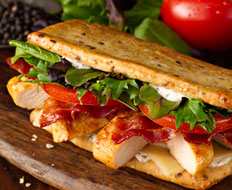After two years of planning, trials, tests, retooling, and finding a vendor willing to spend millions on a new ingredient, Wendy’s is rolling out its latest offering: Flatbread Grilled Chicken Sandwiches.
The Smoky Honey Mustard and Asiago Ranch limited-time offers hit stores nationwide this week in an effort to compete with flatbreads from Subway, Panera Bread, and other quick-serve brands.
“There is a lot of innovation going on here,” says Lori Estrada, senior vice president of research and development, speaking at the Dublin, Ohio–based company’s campus during a behind-the-scenes media tour. “We are constantly looking at our menu and the world of food.”
Made with five whole grains—millet, flax and sesame seeds, cracked wheat, and rolled oats—the new flatbread carrier provides a slightly crunchy texture and moderately nutty flavor. “We ended up with a really unique way to deliver grilled chicken,” says Andy Vincent, Wendy’s director of product development.
The other ingredients in the sandwiches already existed in Wendy’s kitchens: grilled chicken breast, 9-greens salad mix, tomatoes, and salad dressings, plus bacon and Asiago cheese for the Asiago Ranch version. The smoky honey mustard sauce introduced last year updated the previous honey mustard dressing, but it was designed specifically for the flatbread sandwich.
The new flatbread item is the kind of innovation the quick-service industry needs to focus on if it hopes to compete with the fast-casual sector, the only restaurant segment showing growth, says Bonnie Riggs, restaurant analyst for market research firm NPD Group.
“Consumers say they want more choices, more variety,” she says. “Those [restaurants] with the most innovative, creative items and [who] meet consumer needs are the ones who will win the consumer battle.”
Flatbread items also provide a tasty, better-for-you option that appeals to women, Riggs says.
Wendy’s Smoky Honey Mustard flatbread sandwich clocks in at 370 calories with a price tag of $3.49. The Asiago Ranch option has 530 calories and costs $3.99.
Estrada says the sandwiches evolved from a process that combines Wendy’s
culinary development team and marketing staff in fostering a “big idea.” Work began in early 2011 with a focus group to consider the flatbreads’ viability. Among the questions Wendy’s asked were “can we deliver [the item, and] what emotion does it elicit?” says Teressa Johnson, director of sensory science and technical support.
Because the flatbread was a new item, a certified master chef was brought in to help develop the product.
In designing any menu item, the company relies heavily on tasting groups that include consumers, Wendy’s staffers, and a nine-person Descriptive Analysis Panel. The panel, which does not include Wendy’s employees, is selective, and members must have a highly sensitive sense of smell. They are also trained to differentiate and describe the tastes, textures, colors, and other features of food they test, Johnson says.
Separately, consumer tests take place in an area at the Innovation Center that takes the bias out of tasting. Air movement removes odors in and around 16 white sensory booths, and lighting disguises an item’s color.
The Innovation Center features three kitchen lines, reflecting the back of house at different types of Wendy’s restaurants. This allows the R&D team to conduct operational tests to make sure that a new product can be produced the same on each of the lines.
Originally, six flatbread sandwiches were developed, a list that was whittled to four—Smoky Honey Mustard, Asiago Ranch, Caprese, and Smoky Apple Barbecue—for fall 2011 tests in Wendy’s restaurants throughout three markets. After receiving feedback from consumers and restaurant operators, the development team decided to tweak the sandwiches.
“We needed to make changes” to perfect the ingredient mix, Vincent says. The product was so unique, he says, that there was nothing to compare it against in the category.
By the time the second set of regional trials was conducted in four markets last spring, only the Smoky Honey Mustard and Asiago Ranch flatbread sandwiches were included. Meanwhile, Wendy’s discovered it had only one vendor who could make the flatbread.
“We had to go out and find another bakery to spend millions” on the equipment needed to bake the flatbread, Estrada says. Once a vendor stepped up, it took months to acquire the equipment (much of which is made in Europe) to get the new production line running.
The LTO will continue through May. If successful, the flatbread sandwiches could be a platform for additional flavors, company officials say.


